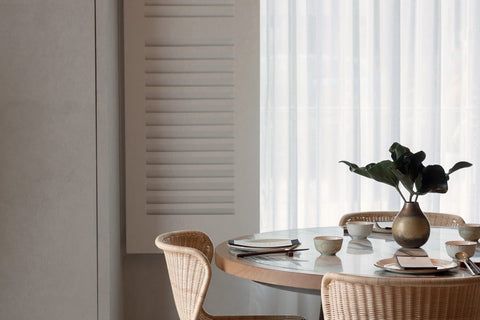AN INTERVIEW WITH SINGAPORE BASED LO & BEHOLD GROUP
THE BUILDING IS ICONIC, AND VERY FAMILIAR TO MANY SINGAPOREANS. WE WERE FORTUNATE TO HAVE CONVINCED THE OWNER TO HAVE US ON BOARD TO CONCEPTUALISE AND OPERATE THE SPACE. IT HAS BEEN AN INCREDIBLE EXPERIENCE TO BRING THE BUILDING'S RICH HERITAGE AND STORY TO LIFE, THROUGH OUR DESIGN AND INTERPRETATION

Mottled rays peek through the skylight of an 1820s shophouse in Kampong Glam, a historic enclave in Singapore named after the paperbark trees (in the Malay language) that used to flourish in the locale. I step into a conference room that feels more like a garden; a patio-like area, brimming with potted plants, forms the centrepiece of the space. Accented with a ventilation block and terrazzo bench, it is befitting that this is the office of Wee Teng Wen, co-founder of The Lo & Behold Group — a lifestyle company renowned for its thoughtful approach in developing any concept. As he shares the fastidious process in creating The Warehouse Hotel and modern French restaurant, Odette, these establishments form a prism through which I catch a glimpse of Teng Wen’s design philosophy: reflecting on Singapore’s past to chart a new future.

Cereal: What was the inspiration behind the name — The Lo & Behold Group?
Wee Teng Wen (WTW): We came up with it about 10 years ago, after starting Loof (Singapore’s first standalone rooftop bar). It was the perfect phrase for us — an old-world exclamation that exudes a feeling of amazement. This aligns with the vision for many of our projects: They should be distinctive, and elicit a sense of wonder for guests and staff alike.
Cereal: The lifestyle group has grown to incorporate many establishments since its inception in 2005. Is there a common thread that runs through them?
WTW: With each new venture, we try to create stories that can stand the test of time. Future-proofing a concept requires a certain timelessness built into each offering. We also approach each project with a lot of passion, and hopefully this can be seen in the details and ideas that go into each space.


Cereal: Has The Lo & Behold Group’s vision evolved over time?
WTW: The original vision was simple: We wanted to inject more soul, fun, and lovability to Singapore’s lifestyle and hospitality scene. When I came back to Singapore from the US, the country felt somewhat sterile. We weren’t exactly known for our vibrant lifestyle and hospitality scene, and we wanted to address that.
After five years, we had managed to come up with a few distinct and successful concepts, but there was still no group alignment and synergy between our venues. Since we’d created multiple concepts, you’d assume that we would have momentum, but from a management perspective, it was a chaotic, difficult time. As leader of the group, this was particularly frustrating for me. Ever since, I’ve been passionately advocating a ‘people-first’ company culture. Only with a robust company culture can we create exceptional experiences for our guests. That is now the common thread.
Cereal: What is the company’s concept development process like?
WTW: It used to be solely free-flowing and emotive. But over time, we’ve combined that creativity with greater structure and rigour. The ‘anything-goes’ brainstorm sessions are now combined with a research-driven approach. The starting point is always about filling a gap in the market. Following that, we zero in all the elements that help to tell the story: Everything from the uniforms to the music; from the sequence of service to the scent. We research, test, and debate these things long before the opening day.
Cereal: The Warehouse Hotel is The Lo & Behold Group’s first foray into the travel and hospitality industry. How did you come to this decision?
WTW: As with many projects, we first fell in love with the space. The building is iconic, and very familiar to many Singaporeans. We were fortunate to have convinced the owner to have us on board to conceptualise and operate the space. It has been an incredible experience to bring the building’s rich heritage and story to life, through our design and interpretation of offering.


Cereal: What is the history behind this former godown?
WTW: It has a dark, mysterious, and illicit history. The building has its origin in the spice trade, whereby boats from the Straits of Malacca would often dock here. It was at the epicentre of illegal clans, with moonshine produced in these warehouses and opium stored in these dens. In the early 1980s and 1990s, this warehouse was an iconic disco — it was the place to discover underground electronic music, and where Lincoln Cheng (founder of iconic nightspot, Zouk) would throw his parties. We wanted to bring back some of this flavour to the hotel, as seen in the hotel’s industrial interior. As a nod to our illicit past, we have a store in our lobby called ‘Objects of Vice’ where items like hip flasks, bottle openers, and whips are available for purchase.
Cereal: Why is this Singaporean story important to you?
WTW: Most hotels haven’t really attempted to tell a Singaporean story, perhaps best exemplified by the generic fruit bowls you often find in hotel rooms. We recently launched homemade pineapple tarts for every guest that checks into The Warehouse Hotel — this is our way of championing the small things that make us unique. This story is of Singapore celebrating her roots and coming into her own, whereby she needs not reference, borrow, or copy from the world.
In the case of Po (the hotel restaurant), the main inspiration was popiah (Southeast Asian spring roll). It’s a comfort food classic that is traditionally made at family gatherings in Singapore. Everyone’s favourite popiah is their grandmother’s. The communal process of sitting around, making, and eating your own popiah is what makes popiah a special dish, which is why we have chosen to celebrate it.

Cereal: The Michelin-starred Odette is another establishment by your group that’s located within a historic building, the National Gallery Singapore. How did Chef Julien Royer and you come together for this restaurant?
WTW: For the restaurant concept, it emerged from the first brainstorm. We were thinking about potential restaurant names, and I, seemingly out of the blue, asked him this question: “What is your grandmother’s name?” It was an off-the-cuff question, but he began to tell me how his grandmother was the inspiration behind him starting out as a chef. She was the one who taught him about respecting produce, on approaching cooking in a simple fashion, and how to elevate each ingredient. We built everything around his grandmother; the restaurant is a tribute to her and her philosophy.
Cereal: Given that the culinary landscape in Singapore is increasingly crowded today, what do you think differentiates Odette from the other restaurants?
WTW: Both Julien and I believe that a restaurant should be uncompromising on both the food and hospitality fronts. Many chef-driven restaurants can be overly focussed on the food, and take themselves a bit too seriously. They can forget that guests are really there to have a great time, and not to be on the edge of their seat in a super formal setting. With Odette, we were fanatical about creating a welcoming, relaxed atmosphere — where the staff are laid back but efficient in their service.
Cereal: Would you consider ‘art’ to be a focal point of the restaurant?
WTW: With Odette situated at the National Gallery, having the restaurant perceived and interpreted as a piece of moving art, where all the elements come together, felt like a natural extension. The aerial installation and art pieces in our restaurant, conceptualised by Singaporean artist, Dawn Ng, were inspired by Julien’s cooking philosophy and respect for his ingredients.

- WORDS: Joseph Koh
- PHOTOS: Hosanna Swee
- ORIGINAL POST: Readcereal

